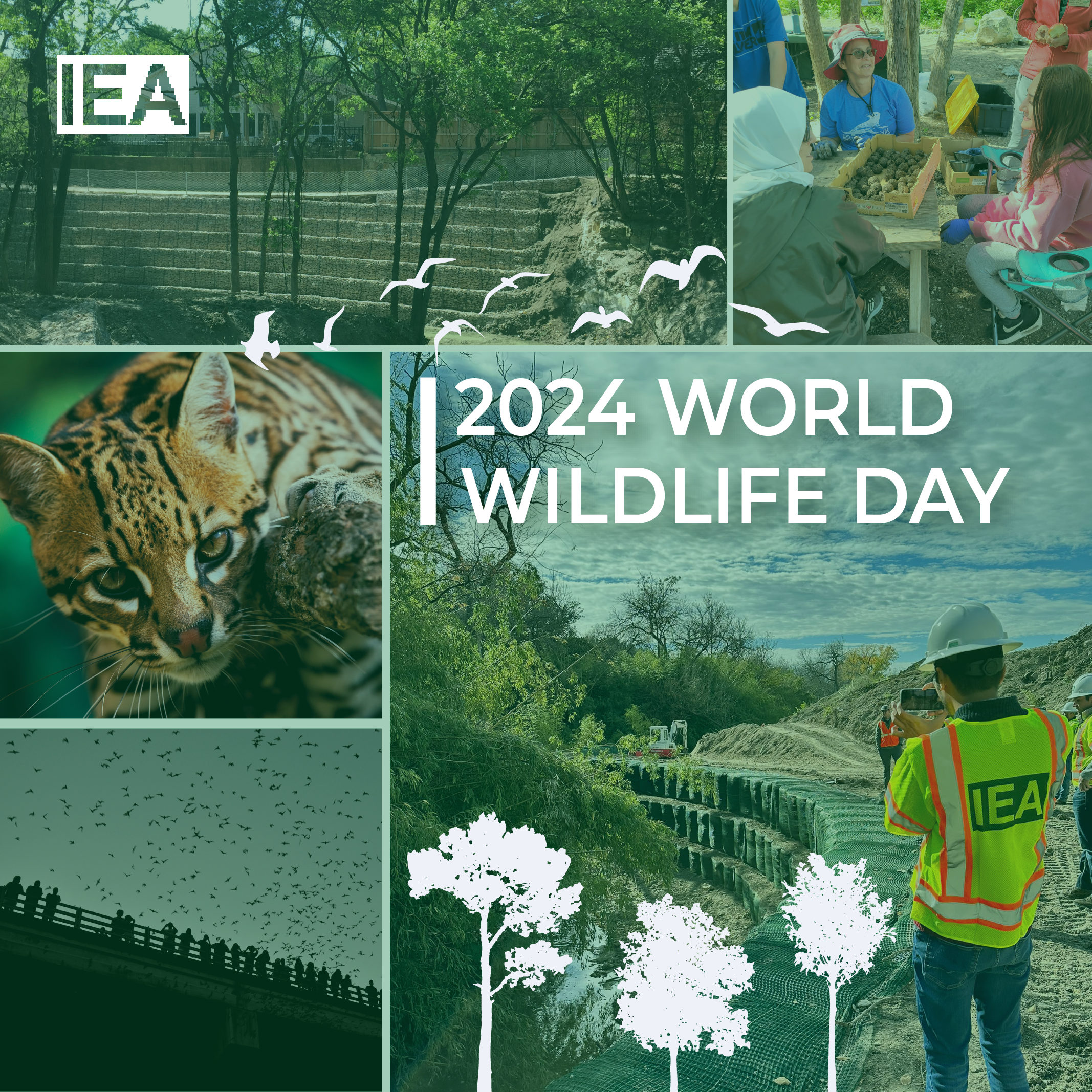Nature and Infrastructure – IEA Leverages Technology to Develop Solutions
IEA joins World Wildlife Day's mission to connect people with the natural world.
World Wildlife Day 2024 (WWD2024) on March 3, 2024 offers a jumping off point for civil engineers to explore possibilities to innovate solutions for the world’s ecosystems with their projects.
This year’s theme is “Connecting People and Planet: Exploring Digital Innovation in Wildlife Conservation.” This annual day was established by the United Nations in 2013 to celebrate awareness of the world’s animal and plant species. WWD2024 sheds light on how organizations like IEA can use technology support the goals of wildlife conservation.
“The digital innovation portion of the theme implies that we should begin leveraging the powerful digital tools at our disposal to design projects that help mankind and limit the adverse effects on wildlife,” said Justin Toone, PE, IEA Dallas Senior Engineer. “One of these powerful tools is geographic information systems (GIS), [this tool] analyzes data and makes decisions based on data, not politics.”
According to National Geographic, GIS is a computer system for capturing, storing, checking, and displaying data related to positions on the Earth’s surface. Toone uses GIS to visually see the geographic context of his projects.
“GIS, Computer Aided Drafting and Design (CADD) Programs, and other analysis tools can help designers identify problem areas early in a project’s life and take appropriate measures to minimize the impacts on wildlife,” said Toone.
IEA works with environmental experts to identify environmental constraints early, including wildlife, so our engineers can incorporate them into the decision-making process and minimize impacts.
“Our professional biologists hold permits to conduct surveys for many different species,” said Dean Tesmer, Managing Director – Transportation at ICF.
Tesmer is currently working with IEA on a Schematic and Environmental project in TxDOT’s Odessa District along SH 18.
The team is using technology to collect data, map wildlife habitats, communicate with team members – both environmental and engineering – and developing design solutions to avoid potential conflicts.
“We are taking an existing 2-lane roadway to a 4-lane divided section,” said Jordan Hasler, PE, IEA Fort Worth Project Manager. “Through coordination with Dean Tesmer, his team, and the dynamic capabilities of OpenRoads 3D modeling, we were able to optimize our design to upgrade the roadway facility and minimize the impact to endangered species in the area.”
OpenRoads helps improve coordination across various disciplines. The elements that make up IEA projects (for example – alignments, pavement, drainage systems, utilities) are brought to life in a powerful 3D model which helps the team identify conflicts.
“Most of the IEA people I have worked with are civil engineers, but my experience is they wear another hat as environmental engineers,” said Tesmer. “IEA’s efforts help protect wildlife habitats and enhance the natural environment.”
NEPA (National Environmental Policy Act and Project Development) is the cornerstone of environmental laws and regulations for federally funded projects, according to Tesmer. These guidelines must be followed by TxDOT, so our engineers look for animal reserves and natural habitats when planning projects.
“These regulations emphasize the importance of a thorough environmental impact assessment during projects,” said Toone. “Especially when dealing with wildlife and their natural habitats.”
After environmental and schematic engineers coordinate to develop solutions to wildlife issues and concerns, infrastructure projects move to final design prior to the construction phases.
“Once the alignment is established within [the project] limits, bridge engineers do not typically receive additional or separate environmental information to be considered in bridge design,” said Hyerang Kim, PE, IEA Dallas Senior Bridge Engineer. “The impact of preserving natural habitat is more significant during the construction stage.”
Designers prepare construction plans to provide the measures and requirements necessary to address each environmental aspect of the project to the Contractor.
“The most common requirement is related to migratory birds,” said Bobby Ramthun, PE, IEA Austin CEI Senior Project Manager. “This is where tree trimming and brush removal is limited to occur during a specified time frame – typically in the fall through the winter.”
A key challenge many infrastructural projects face is the number of people and organizations involved in decision-making.
“When developing the scope of a project, attention should be paid to the amount of coordination required between the designers, stakeholders, and permitting authorities,” said Toone. “Constant communication and effective development of design alternatives are critical to a successful construction project that minimizes potential habitat losses.”
IEA leverages technology for virtual meetings, such as Microsoft Teams, when communicating with our clients, applicable government agencies, community groups, and stakeholders.
“Technology is amazing because there are a lot of benefits and productivity that can be gained from the ideas of entrepreneurs and innovative thinkers without increasing labor effort,” said Alberto Dorantes, PE, IEA Houston Project Manager.

